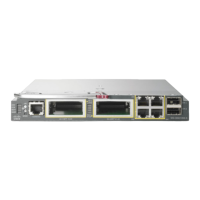39-23
Cisco Catalyst Blade Switch 3120 for HP Software Configuration Guide
OL-12247-01
Chapter 39 Configuring IPv6 Unicast Routing
Configuring IPv6
Beginning in privileged EXEC mode, follow these required and optional steps to configure IPv6 OSPF:
Command Purpose
Step 1
configure terminal Enter global configuration mode.
Step 2
ipv6 router ospf process-id Enable OSPF router configuration mode for the process. The
process ID is the number assigned administratively when
enabling the OSPF for IPv6 routing process. It is locally
assigned and can be a positive integer from 1 to 65535.
Step 3
area area-id range {ipv6-prefix/prefix length}
[advertise | not-advertise] [cost cost]
(Optional) Consolidate and summarize routes at an area
boundary.
• area-id—Identifier of the area about which routes are to be
summarized. It can be specified as either a decimal value or
as an IPv6 prefix.
• ipv6-prefix/prefix length—The destination IPv6 network and
a decimal value that shows how many of the high-order
contiguous bits of the address comprise the prefix (the
network portion of the address). A slash mark (/) must
precede the decimal value.
• advertise—(Optional) Set the address range status to
advertise and generate a Type 3 summary link-state
advertisement (LSA).
• not-advertise—(Optional) Set the address range status to
DoNotAdvertise. The Type 3 summary LSA is suppressed,
and component networks remain hidden from other
networks.
• cost cost—(Optional) Metric or cost for this summary route,
which is used during OSPF SPF calculation to determine the
shortest paths to the destination. The value can be 0 to
16777215.
Step 4
maximum paths number-paths (Optional) Define the maximum number of equal-cost routes to
the same destination that IPv6 OSPF should enter in the routing
table. The range is from 1 to 64, and the default is 16 paths.
Step 5
exit Return to global configuration mode.
Step 6
interface interface-id Enter interface configuration mode, and specify the Layer 3
interface to configure.
Step 7
ipv6 ospf process-id area area-id [instance
instance-id]
Enable OSPF for IPv6 on the interface.
• instance instance-id—(Optional) Instance identifier.
Step 8
end Return to privileged EXEC mode.
Step 9
show ipv6 ospf [process-id] [area-id] interface
[interface-id]
or
show ipv6 ospf [process-id] [area-id]
Display information about OSPF interfaces.
Display general information about OSPF routing processes.
Step 10
copy running-config startup-config (Optional) Save your entries in the configuration file.

